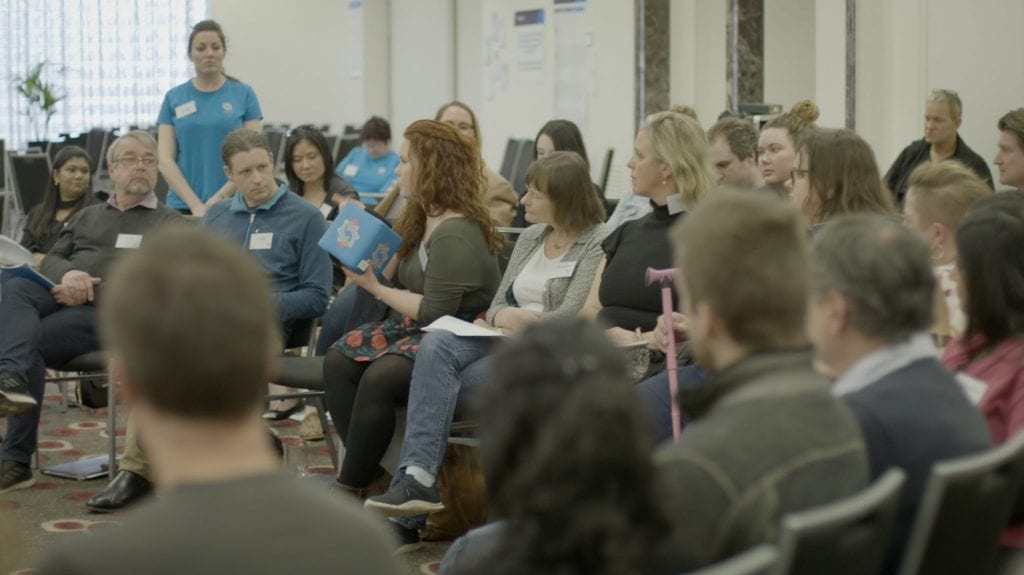How did a group this disparate come to spend an entire weekend debating the pros and cons of gender-based employment quotas?
The Victorian government is rolling out a Gender Equality Strategy and one of the initiatives of this strategy is a draft Bill on quotas for men and women working in the state’s public sector. Because this is an issue of intense public interest, the views of the general public are being sought to help shape the Bill.
An independent consulting firm invited expressions of interest from 14,000 Victorians to participate in a Citizens’ Jury. Over 100 were selected based on their demographics (age, sex, ethnic background, geographic location, declared disability, etc.) to be a representative sample of the state’s population. In September, the group convened in Melbourne for two full days of facilitated discussion.
What Gender Equality quotas are fair? How can they be best implemented? Our remit was to answer these questions, and present recommendations for the draft Gender Equality Bill. Simple, right? Needless to say, there were some pretty heated discussions over that cold weekend. But for all the differences of opinion, the incompatible world views, the variety of life experiences that had brought us all to this point, there was one thing we could all agree on: we want to create a society where there is no need for gender-based quotas.
Now, how do we get there?
The first point of contention was quotas versus targets. A target is a goal, usually identified and set by the organisation or industry to which it applies, and without external enforcement. A quota, on the other hand, is imposed and enforced by law. We debated the benefits of both approaches, and tried to foresee the potential unintended consequences of each.
Although it’s easy to assume that the question of gender-based quotas is just a question of increasing participation of women in the workforce, we talked in depth about also increasing men in the care and education sectors, as well as achieving a more equitable gender balance at all levels of employment – not just in executive leadership, and on boards. With that in mind, we considered what would need to change to better train, attract, and recruit meritorious candidates of all genders to sectors with severe gender inequality. And should every organisation aim for a 50/50 balance? Or might a 40/40/20 split (i.e., 40% minimum of men, 40% minimum of women, and 20% flexibility) be just as fair, or easier to achieve? How soon can we expect organisations to get there? Five years? Ten?
The Citizens’ Jury was provided with a background paper (Word doc: statistics about the state of the public sector in Victoria, examples of where gender-based quotas have been used in other parts of the world, and a panel of three employment law and gender equality policy experts. We were encouraged to find and share other sources of information too, including on an online forum available to us before and after the weekend of deliberations. And we were introduced to critical thinking skills, recognising unconscious bias, and cognitive types to help us better understand the different styles and approaches we all have to problem solving.
Armed with these new skills and evidence, and under the expert facilitation of the jury organisers, we spent two days in various combinations and permutations of our fellow citizens. In small groups we wrote proposals which were put up for us all as individuals to comment and vote on. These were then given to different small groups for consolidating, refining, and redrafting, before being brought back again to the whole jury for final comment and voting.
So, do you think we were able to find any agreement, let alone a super majority of 80% of the jury, on any of the thorny issues raised? Yup! Our recommendations included:
- 40/40/20 quotas for recruitment at all levels in all parts of the Victorian public sector within 10 years, except for gender-specific roles protected under the Sex Discrimination Act, and with the possibility of exemptions under exceptional circumstances;
- Monitoring of and reporting on progress toward gender equity by an independent agency; and
- The quotas should be supported by a slew of other policies and measures, especially de-gendered carers’ leave and flexible work arrangements to encourage men to take on parental leave and decrease discrimination against mothers with primary care responsibilities
Views not endorsed by the super majority were expressed in minority reports. These included the opinions that gender-based quotas should not be introduced to the Victorian public sector at all, that the principle of gender equality should be extended to the state government procurement practices (which it is), and that the Citizen’s Jury was flawed.
The process wasn’t perfect – how could it be? – but no-one (that I heard) argued against it happening at all. Of all the criticisms levelled against the Citizens’ Jury, the common refrain was one of ‘more of the good stuff, please’: more evidence, more variety of sources, more time, more discussions, more voting. And that sounds to me like a resounding vote of confidence for deliberative democracy.
If you have something to say about Victoria’s Gender Equality Bill, you can have your say online until 28 September: https://engage.vic.gov.au/gender-equality


